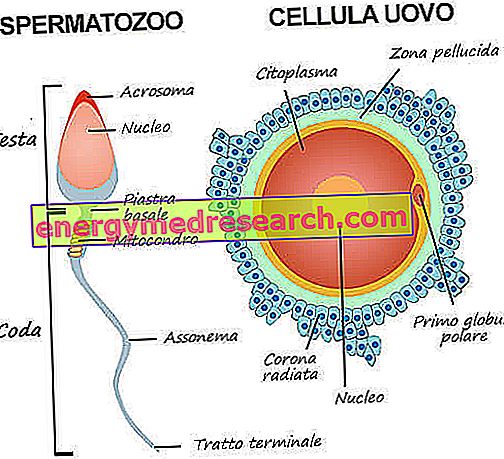Generality
Gametes - also known as sexual or gametic cells - are haploid cells that are responsible for the reproduction of the species.
The production of gametes belongs to the gonads, which are the primary sexual organs of the reproductive apparatus of the human being.
The gametes of man are different from the gametes of the woman: the male gametes are the spermatozoa, while the female gametes are the egg cells.

Spermatozoa are the result of the spermatogenesis process; egg cells, on the other hand, are the result of the process of oogenesis.
What are gametes?
The gametes (in the singular gamete ) are the cells necessary for reproduction.
In humans, gametes are spermatozoa ; in women, however, they are egg cells (or eggs or oocytes ).
Also known as the wording of sex cells or gametic cells, the gametes are the result of the activity of the gonads .
WHAT ARE THE GONADES?
The gonads are the primary sexual organs of the reproductive system (or genital apparatus ) of the human being.
They are endocrine glands, which have the important function of secreting, in addition to the gametes, also the sex hormones, which play a key role in the development of secondary sexual characteristics and in the control of the genital apparatus.
The man's gonads are different from the woman's gonads: the male gonads are the testicles, while the female gonads are the ovaries (in the singular ovary, but also the ovary or ovary ).
Summary of the role of male and female gonads | ||
| gonads | What sex hormones? | What gametes? |
| Testicles | Androgens:
| Sperm |
| Ovaries | Progesterone estrogens | Egg cells |
ORIGIN OF THE NAME
The terms "gameti" and "gamete" derive from the Greek word " γαμετή ", which means "to marry" or "to unite".
The use of terms with this etymological origin is a clear reference to the reproductive function of cells, to which the aforementioned terms refer.
Features
Unlike all other cells in the human body ( somatic cells ), which are diploid, the gametes are haploid .
- In genetics, all cells containing only one copy for each chromosome ( haploidy ) are defined as haploid, while all cells containing two copies for each chromosome ( diploidy ) are called diploids.
- In spermatozoa, the chromosomes present actually represent half of a man's chromosomal outfit.
- Similarly, in egg cells, the chromosomes present are in fact half of a woman's chromosome set.
- The haploid condition, which characterizes the gametes, is essential for reproduction.
SPERM
The spermatozoon is a very small cell, whose dimensions can vary between 5 and 7 micrometers.
Its structure is particular and includes:
- A head, containing the cell nucleus and acrosome ;
- An intermediate portion, rich in mitochondria;
- A tail, equipped with mobility and called a flagellum .

EGG CELLS
At about 0.12 mm in diameter, the egg cell represents one of the largest cells in the human body, so that it can be seen even with the naked eye, without the support of the microscope.
The cytoplasm of the egg cell is rich in reserve phospholipid materials, which serve to address the various steps to which it will be subjected and a possible fertilization.
Training
Spermatogenesis and oogenesis are the terms that indicate, respectively, the process of formation and maturation of gametes in humans and the process of formation and maturation of gametes in women.
Meiosis characterizes both spermatogenesis and oogenesis.
Meiosis is that complicated process of division, typical of eukaryotic organisms, at the end of which a diploid cell becomes haploid. In other words, subjected to meiosis, a cell with two copies for each chromosome becomes a cell with only one copy for each chromosome.
SPERMATOGENESIS
In a healthy male, the testes produce about 100-200 million sperms a day.
Duration of about 64 days, the process of sperm formation and maturation begins in the seminiferous tubules of each testicle and continues into the epididymis . The permanence in the epididymis is about 12 days and it is essential to give the spermatozoa the mobility that distinguishes them.
Once the maturation process is complete, the spermatozoa are stored and ready for ejaculation .
In the absence of ejaculatory events, spermatozoa have a limited life within the testicles. In fact, over time they degenerate and are reabsorbed by the vas deferens of the testicles.
It should be pointed out that spermatogenesis is a continuous process, endowed with its own productive rhythm. This implies that there is continuous sperm turnover within the testicles.
In humans, spermatogenesis starts from puberty ; before that, therefore, the testicles do not produce gametes.
oogenesis
In a healthy woman, the ovaries mature only one egg cell every 28 days (duration of oogenesis).
The oogenesis can be divided into three important moments, which in chronological order from the first to the last are: the follicular phase, the ovulatory phase (or ovulation ) and the luteal phase .
- The follicular phase is the time when the ovaries, after a precise hormonal stimulation, produce and bring to maturity, within a follicle, the future egg cell. At this stage, the egg cell is called the primitive egg cell or primitive oocyte .
- The ovulatory phase is the moment in which, following a hormonal stimulus different from the previous one, the now mature egg cell detaches from the follicle (and from the ovary) and nestles in the fallopian tubes, ready to meet with an eventual spermatozoon.
- The luteal phase is the moment in which the follicle becomes the corpus luteum and, in case of failure to fertilize the female gamete, menstruation occurs.
Unlike humans, in whom sperm production begins at puberty, a woman is born with all the primitive egg cells, which in the course of life could at least participate in the first phase of oogenesis.
In this regard, some interesting studies have shown that, in a female subject just born, the number of primitive oocytes is about one million and that, during the course of life, only 500 of them undergo the process of ovulation . This means that 99.95% of primitive oocytes present at birth undergoes degeneration, while only a small 0.05% is the protagonist of the ovulatory phase of oogenesis.
Function
From the meeting and fusion of a male gamete with a female gamete originates a very particular cell, called zygote . The zygote is the first cell of a new individual or, if you prefer, the cell from which the development of the fetus begins.
The zygote formation process is called fertilization . Generally, fertilization takes place in the fallopian tubes .
THE CHEESE
The zygote is a diploid cell.
The chromosome set of the spermatozoon and the chromosomal outfit of the egg cell contribute to its diploidy. In other words, the zygote contains within its nucleus a copy of all the chromosomes of the father of the future unborn child and a copy of all the chromosomes of the mother of the future unborn child.
Immediately after its formation, the zygote moves from the fallopian tubes - canonical site of fertilization - to the uterus . Once in the uterus, it begins to divide (two cells originate from one cell, two originate from two and so on) and gradually grows larger.
After the first divisions, the zygote takes the name of blastocyst . About 8 weeks after the formation of the zygote, the blastocyst becomes what is commonly called a fetus.
HOW IS THE FECONDATION?
In order for fertilization to take place, it is necessary for a sperm to reach the egg cell, located within the female genital apparatus, and penetrate it.
As anticipated, the ability of movement and penetration of the spermatozoon depends on its particular structure: the tail allows movement within the genital organs, while the head and the enzymes contained in the acrosome allow the demolition of the two external protective barriers of the egg cell (radiata crown and translucent area).
In reality - it is good to point out - the spermatozoon that penetrates the egg cell never acts in solitary, but uses the other spermatozoa emitted with ejaculation, to destroy the outer protective barriers of the oocyte. Thus, the large number of male gametes produced daily is only apparently useless.
| The highlights of the male gametes and female gametes | |
| Male gamete | Female gamete |
|
|
|
|
|
|
|
|
|
|
|
|
|
|
|
|
|
|
|
|



